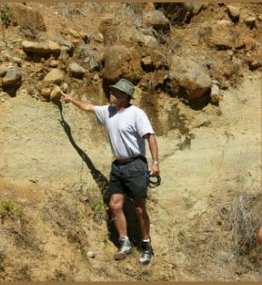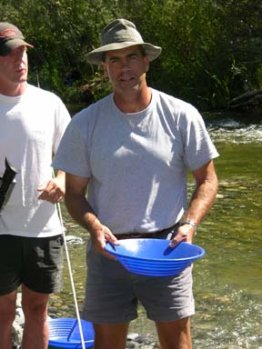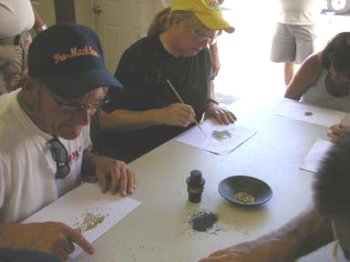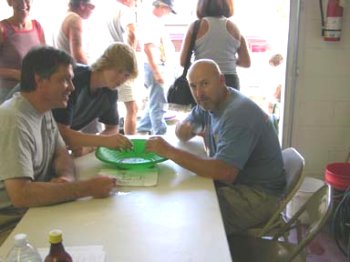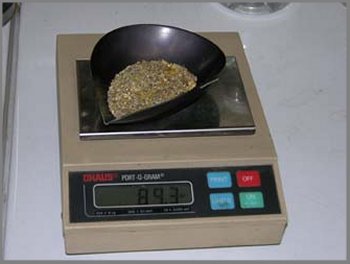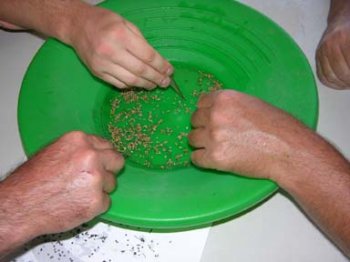
By Sara Koehler
It has been said that there is a time for everything under the sun. Well, the time for dredging is definitely summertime…And, there is no better place to dredge than Happy Camp, California! “Happy Camp.” The very name makes me smile in disbelief! This place really does exist! The water is cool, but not too cold, and the weather is usually quite mild. Better yet, there are “Gold Nuggets” as big as your thumbnail! We always find enough nuggets to make every day feel like a “surprise” birthday party!
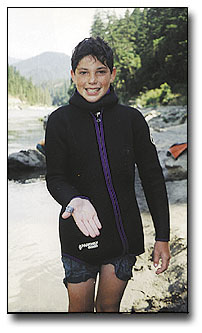 Wherever we settle in for our dredging season, we all work as a team to make our home away from home as comfortable and relaxing as it can be. The children take turns taking care of our trash, making sure we always have a nice, clean camp. Everyone takes turns doing dishes and setting the table for meals…all except for Scott and me! With six children there are plenty of extra hands, eager to be of help.
Wherever we settle in for our dredging season, we all work as a team to make our home away from home as comfortable and relaxing as it can be. The children take turns taking care of our trash, making sure we always have a nice, clean camp. Everyone takes turns doing dishes and setting the table for meals…all except for Scott and me! With six children there are plenty of extra hands, eager to be of help.
When Scott and the boys get our equipment ready to launch at the spot we have chosen on the Klamath River, we dredge for a couple of hours at the beginning of each day. We can’t contain ourselves, and check our sluice box for gold every time we stop the engine to refuel. If some of the children are on the beach and hear the dredge engine being turned off, they all dive into the river and swim up to the edge of the dredge to get a sneak preview. We lift the flare’s flap, and “Surprise,” there are beautiful gold nuggets staring us in the face!
At the end of the day, we jump in our car and drive back to our camp. We try to take turns talking about everything that had happened to us during the day. Our adventure is not just about finding gold; but, also about the frogs, the insects, the birds, the swimming feats, the great lunch, the interesting people we meet at the river, the weather conditions, and all the “little things” that make us laugh.
How did we find this place? We’ve always had an interest in gold mining and had heard about Dave Mack’s videos from a friend of my brother. We bought Dave’s video at a mining equipment store in Sacramento, and had become spellbound watching Dave’s mining techniques, instructions and demonstrations. This is the first time that we had ever heard of the New 49’ers and Happy Camp! I knew that my husband, Scott, was going to get really excited about “all this new information!” Immediately we called the New 49’er office, that very same day!
We don’t want to sound like expert gold nugget hunters, because we’re not. We don’t own any private claims. When we became members of the New 49’ers Prospecting Club we instantly had over 60 miles of mining claims along the Klamath River and its tributaries in the northwest corner of California. Thus, we began our dredging adventure –we signed up for group dredging projects, and we even ordered a 5-inch dredge!
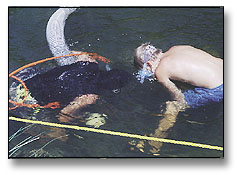 All winter long we watched all of Dave Mack’s videos, so that when we finally got to meet him face-to-face, our kids thought that they already knew him personally. Dave was very surprised, and taken aback, by all the admiration and affection our kids showered on him. If Dave Mack had a free hand, one of my kids had a hold of it. The other ones just waited until another free hand became available so they could latch on. I have to say that Dave took our children’s affection with good cheer and appreciation.
All winter long we watched all of Dave Mack’s videos, so that when we finally got to meet him face-to-face, our kids thought that they already knew him personally. Dave was very surprised, and taken aback, by all the admiration and affection our kids showered on him. If Dave Mack had a free hand, one of my kids had a hold of it. The other ones just waited until another free hand became available so they could latch on. I have to say that Dave took our children’s affection with good cheer and appreciation.
Our six children accompany Scott and me on our gold mining adventures. I do all the cooking and run errands, but there is also plenty of time for me to enjoy reading and sewing on the beach. It is very relaxing, and when Scott comes up for a break or lunch, we enjoy just being together in these great outdoors and fresh air. The children assist in all the various aspects of dredging, but there is plenty of time for swimming, getting sunburned, and eating!
Scott spends as much time as possible under the water, “vacuuming” the bottom of the river. We started out with both Pro-Mack 2-inch and 5-inch dredges. Then the second summer we ordered a 10-inch, customized, “wonder”-dredge. It is a beautiful piece of equipment! Being on it makes one feel like a “King and Queen of the River.”
We made our first trip to Happy Camp in June of 1995. Taking our tents, tent-trailer, and dredges, we camped at the Anderson Campground, on the Klamath River. The weather was chilly and wet, but we sure did have fun anyway! We dredged, panned, and high-banked. We attended group mining projects and attended claim tours. We cooked, washed clothes, read books, talked-over ideas and created many “plans.”
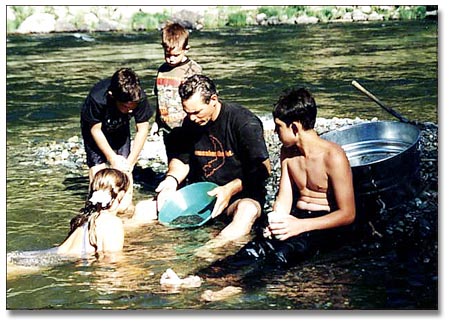 During our first week in Happy Camp the Discovery Channel (Cable TV) paid us a visit at our home on the river. Their crew was producing a show entitled “Easy Does It!” They wanted to film a piece on small-scale gold mining and they spent most all of one day with us. The cameraman filmed Scott dredging and the children panning. They interviewed both Dave Mack and us. The next time we heard from the Discovery Channel was at the end of the summer when they called our home to ask how much gold we had found. A few weeks later they sent us a copy of the 5-minute segment that they had made for television. Then a few months after that we were actually on television! We were thrilled!
During our first week in Happy Camp the Discovery Channel (Cable TV) paid us a visit at our home on the river. Their crew was producing a show entitled “Easy Does It!” They wanted to film a piece on small-scale gold mining and they spent most all of one day with us. The cameraman filmed Scott dredging and the children panning. They interviewed both Dave Mack and us. The next time we heard from the Discovery Channel was at the end of the summer when they called our home to ask how much gold we had found. A few weeks later they sent us a copy of the 5-minute segment that they had made for television. Then a few months after that we were actually on television! We were thrilled!
After our time at “Anderson Campground,” we moved to a place down-river from Happy Camp named Independence. During that same first summer we camped on a roadside turnout, 230-feet above the claim. Getting down to the river each morning, which was a difficult access from that location (downhill), made for an exciting beginning and ending of each day. Scott and the kids immediately went to work cutting a trail down to the river. It was a very steep trail, and perilously paved with poison oak! Our children became experts in identifying poison oak! The section of river we were on had small and large boulders that created a nice area for our kids to swim in, away for the rushing flow of the Klamath. 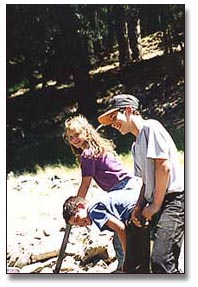 It was deep enough and safe enough for Ben, our youngest, to dive off some of the boulders. At the end of the day we would all get filthy-dirty clawing our way back up to our camp. The “best,” or should I say most challenging, part of the day was that we had no running water! But, otherwise we certainly got a lot of great exercise! That particular summer was extremely hot, and there was no break from either the heat or the “jack-braked” semi-trucks. The high point of our experience at Independence was being invited by some very hospitable, new friends to take showers in their home!
It was deep enough and safe enough for Ben, our youngest, to dive off some of the boulders. At the end of the day we would all get filthy-dirty clawing our way back up to our camp. The “best,” or should I say most challenging, part of the day was that we had no running water! But, otherwise we certainly got a lot of great exercise! That particular summer was extremely hot, and there was no break from either the heat or the “jack-braked” semi-trucks. The high point of our experience at Independence was being invited by some very hospitable, new friends to take showers in their home!
The next summer, 1996, we stayed with friends in their house, and felt free to dredge anywhere that looked appealing. We learned how to work the 10-inch dredge. We couldn’t believe the attention the dredge received, running or not. It has incredible size, volume, power, and beauty! This is when we first met the Andrezejewski family for the first time.
By the beginning of the summer of 1998 our family was no longer working and functioning in isolation. We teamed up with a wonderful couple, Max and Lesley Andrzejewski, and their five children. They had driven to Happy Camp every summer for three years from Pittsburgh, Pennsylvania with their children. We “hit it off” immediately when we met them for the first time at a weekly New 49’er potluck. We have become extremely good friends since then! We have done so many things together; dredging, eating, shopping, making repairs, putting out fires, and even doctoring “ouch-ies.” All these activities have firmly “cemented” our friendship!
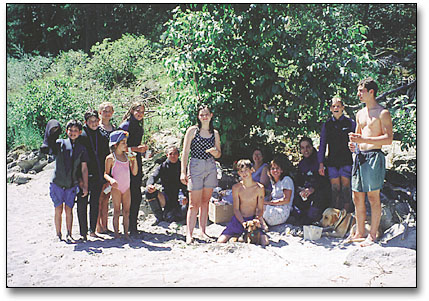 Two sets of parents, eleven children, two dogs, a pan full of gold, and a cool river on a hot day all add up to non-stop adventure and fun! We have all learned a lot from each other in many, many ways! Some of the lessons we learned together even included “bloopers,” such as: Don’t fill your dredge’s gas tank while it is still running; keep plenty of duct-tape on hand; don’t forget to wash your ears out with Domeboro after dredging; peanut butter and jam sandwiches taste best when eaten on a beach; any kind of cookies and chips will be devoured; and be sure to take lots of food to the Saturday night potlucks! Happy Camp is a great place to bring a family. There’s no doubt about it! It’s also a good place to invite your friends to come and visit. The area is really beautiful and the New 49’ers are a great group of people. They are helpful, friendly, hardworking, and adventuresome.
Two sets of parents, eleven children, two dogs, a pan full of gold, and a cool river on a hot day all add up to non-stop adventure and fun! We have all learned a lot from each other in many, many ways! Some of the lessons we learned together even included “bloopers,” such as: Don’t fill your dredge’s gas tank while it is still running; keep plenty of duct-tape on hand; don’t forget to wash your ears out with Domeboro after dredging; peanut butter and jam sandwiches taste best when eaten on a beach; any kind of cookies and chips will be devoured; and be sure to take lots of food to the Saturday night potlucks! Happy Camp is a great place to bring a family. There’s no doubt about it! It’s also a good place to invite your friends to come and visit. The area is really beautiful and the New 49’ers are a great group of people. They are helpful, friendly, hardworking, and adventuresome.
But, did we find many gold nuggets? Yes! We kept our ears open and heard a hot tip from Dave McCracken during one of his river tours with 20 or more people. “Go to this spot! It has nuggets along the far bank,” he said. We checked it out, and sure enough, he was telling the truth!
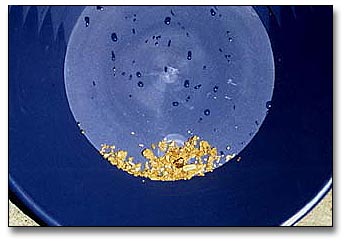 We’ve been coming to Happy Camp for the last four summers. We’ve camped in campgrounds and on a highway turn-out, stayed in a motel, “borrowed” and rented friends’ houses, and this year we’ll probably buy our own property. I will be glad to have a “permanent” place to call home during the summer when that “dredging itch” needs scratching, and we all climb into our car and head back to Happy Camp!
We’ve been coming to Happy Camp for the last four summers. We’ve camped in campgrounds and on a highway turn-out, stayed in a motel, “borrowed” and rented friends’ houses, and this year we’ll probably buy our own property. I will be glad to have a “permanent” place to call home during the summer when that “dredging itch” needs scratching, and we all climb into our car and head back to Happy Camp!
Really, though, we didn’t start gold mining to become rich. God has truly blessed us with a wonderful family and many, very dear friends—who have become family. We have already found the Motherlode!


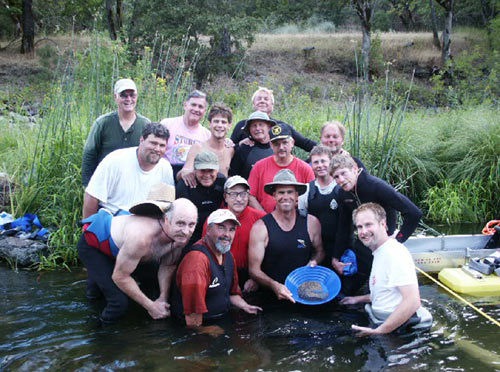
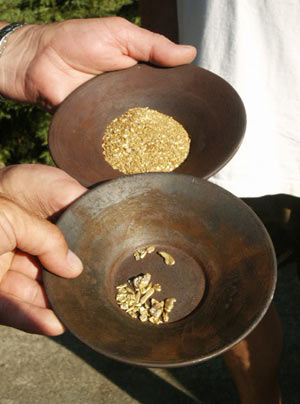 This project included 14 persons, myself, and three additional supervisors who were helping me to manage the program – for a total of 18 people. We were using a 3-inch dredge to get beginners started, two 4-inch dredges and three 5-inch dredges. Each dredge was set up for two divers, so half our crew could be underwater at any given time.
This project included 14 persons, myself, and three additional supervisors who were helping me to manage the program – for a total of 18 people. We were using a 3-inch dredge to get beginners started, two 4-inch dredges and three 5-inch dredges. Each dredge was set up for two divers, so half our crew could be underwater at any given time.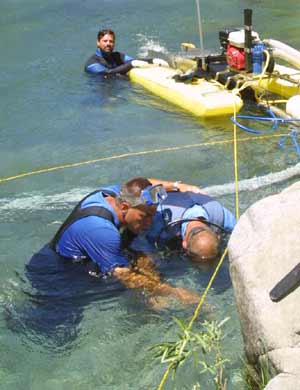
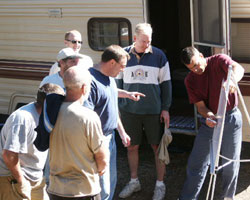
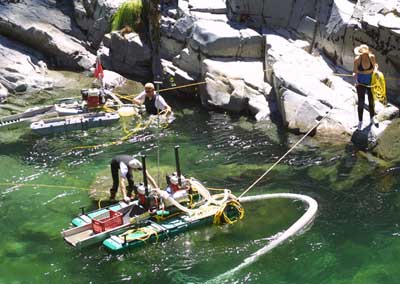
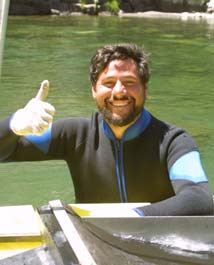
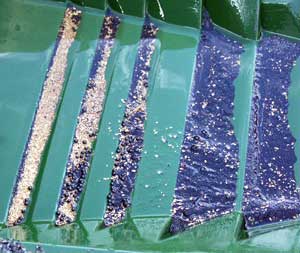
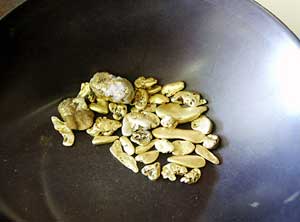
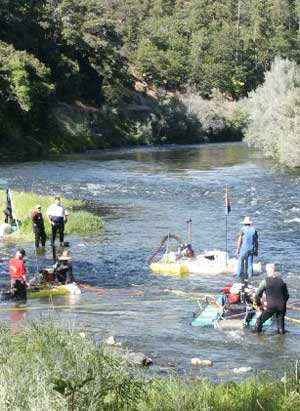
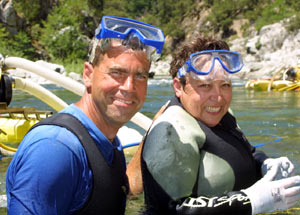
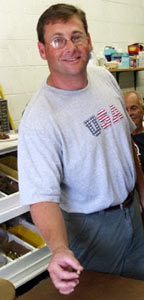
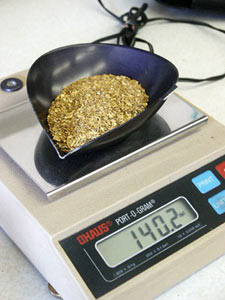

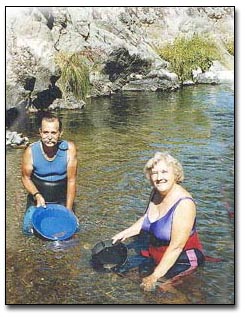 treasure hunting. Their interest began in 1974 when they took a vacation up through the Mother Lode area of California. While there, they decided to try their hand at gold panning.
treasure hunting. Their interest began in 1974 when they took a vacation up through the Mother Lode area of California. While there, they decided to try their hand at gold panning.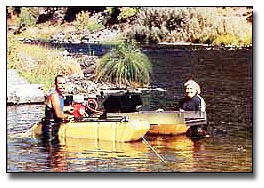 Both Chuck and Chris have a very mischievous twinkle to the eye, and you know that whatever they do, it will be interesting. So when you hear about the unusual finds they’ve made while dredging, it doesn’t surprise you too much. Most people consider themselves lucky if they find one good cache in their lifetime. Chuck and Chris have found two, and they weren’t even looking for them. They found them dredging and panning!
Both Chuck and Chris have a very mischievous twinkle to the eye, and you know that whatever they do, it will be interesting. So when you hear about the unusual finds they’ve made while dredging, it doesn’t surprise you too much. Most people consider themselves lucky if they find one good cache in their lifetime. Chuck and Chris have found two, and they weren’t even looking for them. They found them dredging and panning!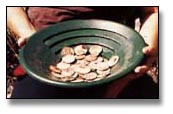 When he finished cleaning out the spot he had a hole about 3 feet in diameter, and 12 to 18 inches deep. Their cache consisted of 35 silver dollars and 3-five dollar gold coins! They have them in safekeeping with their other finds. They decided they didn’t want to even clean them. The newest of the coins was a 1927 silver dollar. The boulder that covered the cache was about the size of an office desk, so they think the cache was lost possibly in a flood, and the boulder came to rest on it some time later. Last year Chuck and Chris went to Alaska and carried their dredge on the truck for 72 days before they found a place they could dredge. They report that there were a lot of places where you could pan, but not many where you could dredge. As always, however, they enjoyed their trip.
When he finished cleaning out the spot he had a hole about 3 feet in diameter, and 12 to 18 inches deep. Their cache consisted of 35 silver dollars and 3-five dollar gold coins! They have them in safekeeping with their other finds. They decided they didn’t want to even clean them. The newest of the coins was a 1927 silver dollar. The boulder that covered the cache was about the size of an office desk, so they think the cache was lost possibly in a flood, and the boulder came to rest on it some time later. Last year Chuck and Chris went to Alaska and carried their dredge on the truck for 72 days before they found a place they could dredge. They report that there were a lot of places where you could pan, but not many where you could dredge. As always, however, they enjoyed their trip.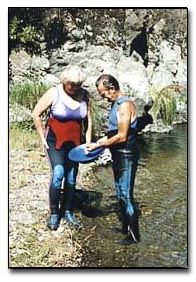 They finished their vacation in Dawson City, Yukon, Canada, at the World Goldpanning Championships, where Chuck and Chris entered the competition. Chris was the only American woman entered, and she won the beginner’s competition!
They finished their vacation in Dawson City, Yukon, Canada, at the World Goldpanning Championships, where Chuck and Chris entered the competition. Chris was the only American woman entered, and she won the beginner’s competition!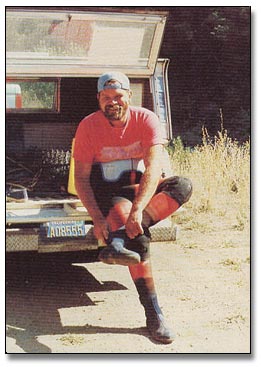 claims and wanted to show this new guy how to put a dredge into the water. He had never seen this kind of operation before. I told him this is “a piece of cake”, I’ve done it many times. So, he just stood there watching us lowering the dredge down into this steep canyon. We had two safety ropes on the dredge, two guys on top of the road; Gordon and myself, guiding the rig down. Suddenly something snapped, I didn’t know what. And there it went! From zero to 60 in 6 seconds. I saw Gordon stepping away from the dredge and running away. One of the security ropes came whirling down the slope like an angry snake and nobody wanted to get caught by it. Finally the trailer with the dredge hit the bank at the end of the slope and tilted sideways.
claims and wanted to show this new guy how to put a dredge into the water. He had never seen this kind of operation before. I told him this is “a piece of cake”, I’ve done it many times. So, he just stood there watching us lowering the dredge down into this steep canyon. We had two safety ropes on the dredge, two guys on top of the road; Gordon and myself, guiding the rig down. Suddenly something snapped, I didn’t know what. And there it went! From zero to 60 in 6 seconds. I saw Gordon stepping away from the dredge and running away. One of the security ropes came whirling down the slope like an angry snake and nobody wanted to get caught by it. Finally the trailer with the dredge hit the bank at the end of the slope and tilted sideways.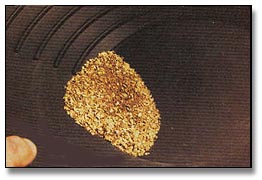 Carl works his new 6-inch dredge with great success making between three-quarters and one ounce a day. He works all summer and goes back to Eureka for the winter where he goes metal detecting along the beaches. When you happen to meet him, ask him about the many other MURPHY stories he has experienced. He will tell you in detail, and laugh about it.
Carl works his new 6-inch dredge with great success making between three-quarters and one ounce a day. He works all summer and goes back to Eureka for the winter where he goes metal detecting along the beaches. When you happen to meet him, ask him about the many other MURPHY stories he has experienced. He will tell you in detail, and laugh about it.
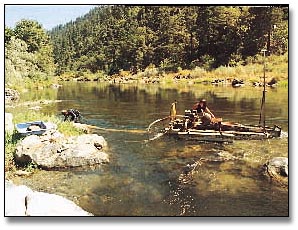 dredgers and saw the gold they recovered and I just had to have one of those machines.”
dredgers and saw the gold they recovered and I just had to have one of those machines.”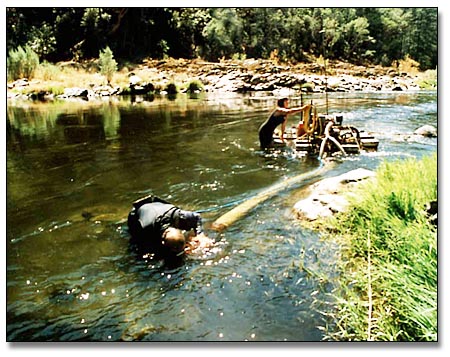 Now it’s 1990 and they’re back. They have a better dredge, better accommodation in a bachelor apartment, met all their friends from last year, and have a good spot in the river to work.
Now it’s 1990 and they’re back. They have a better dredge, better accommodation in a bachelor apartment, met all their friends from last year, and have a good spot in the river to work.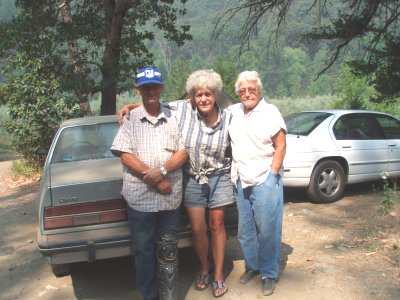
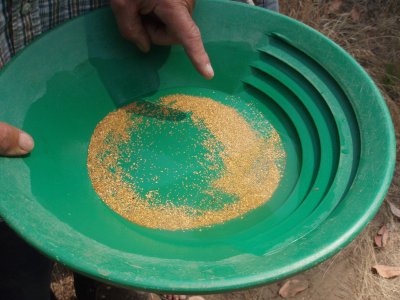
 Both Clarence and Cindy are from the country. Cindy grew up on a dairy farm in Oregon where she was born. She says. “The farm was a lot of physical work and definitely kept me in shape. That kind of living helped prepare me for the mining that we continue to do now.” Clarence ran a sheep and cattle ranch in Idaho, and also a dairy. So he is also very familiar with hard physical work.
Both Clarence and Cindy are from the country. Cindy grew up on a dairy farm in Oregon where she was born. She says. “The farm was a lot of physical work and definitely kept me in shape. That kind of living helped prepare me for the mining that we continue to do now.” Clarence ran a sheep and cattle ranch in Idaho, and also a dairy. So he is also very familiar with hard physical work.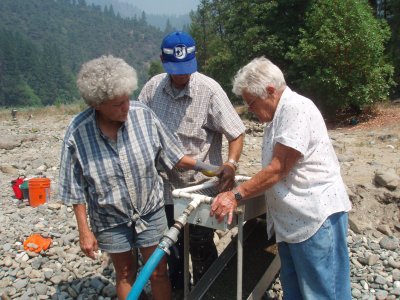 Even Cindy”s mom, Adelma, (who is 78 years old) has joined them. She says that being outside and active has helped keep her feeling young.
Even Cindy”s mom, Adelma, (who is 78 years old) has joined them. She says that being outside and active has helped keep her feeling young.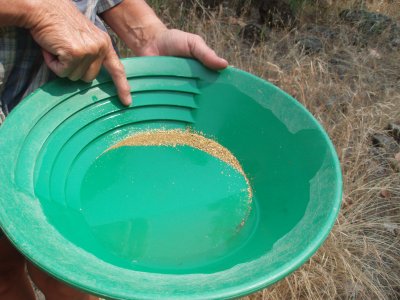
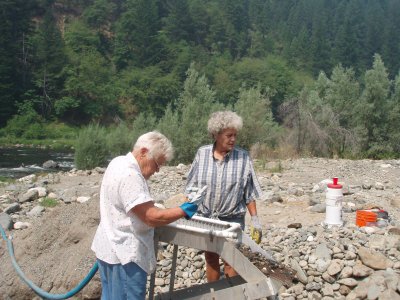

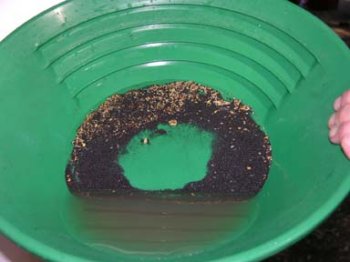
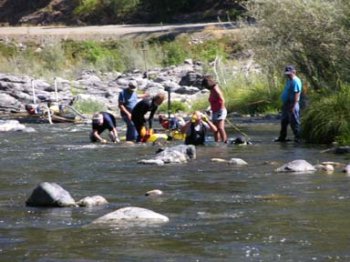
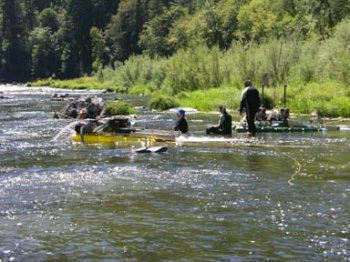
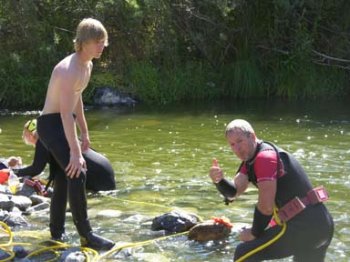 Even though the project took place over a year ago, the story and video segments go a long way to show the camaraderie and great adventures our
Even though the project took place over a year ago, the story and video segments go a long way to show the camaraderie and great adventures our 
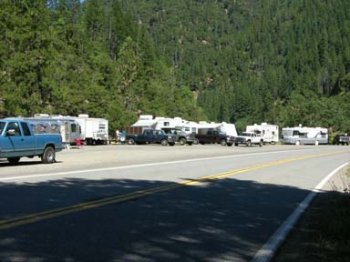 While most of us
While most of us 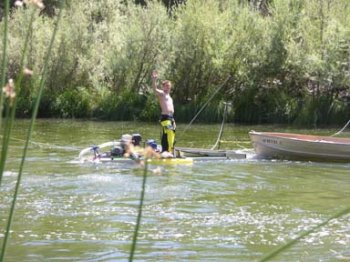
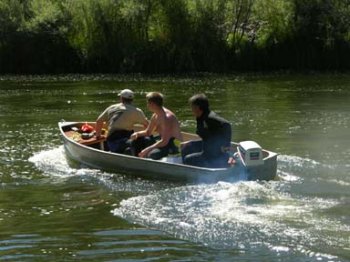
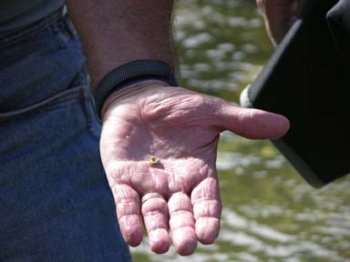
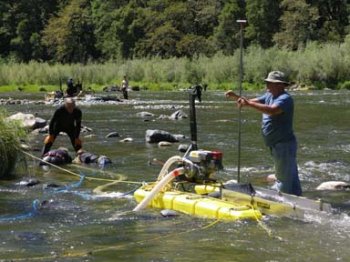
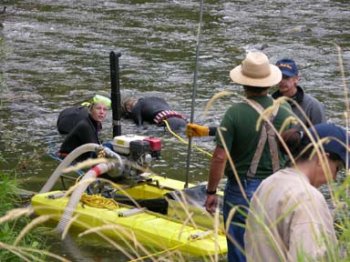
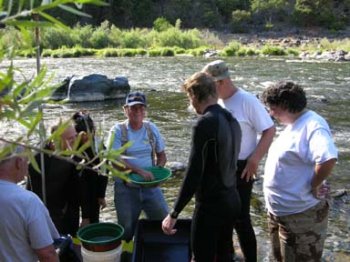
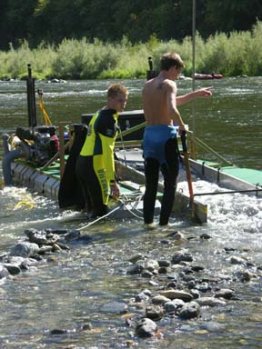
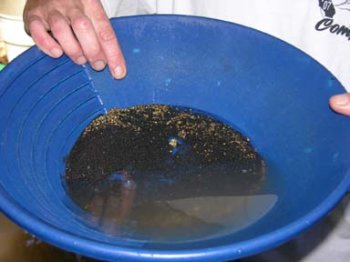
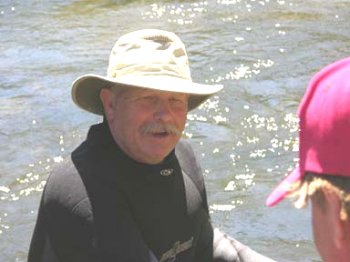
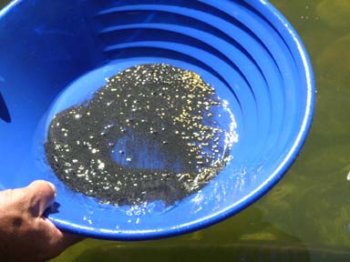
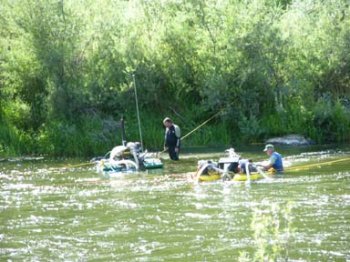
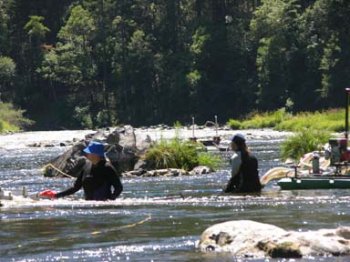
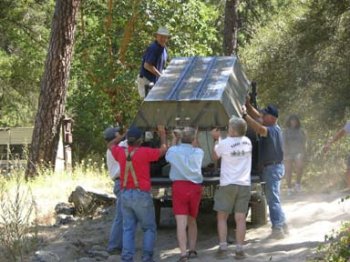
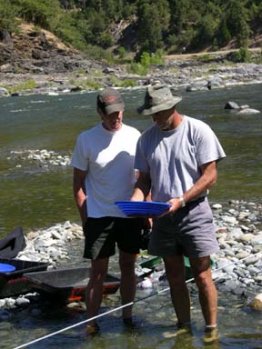
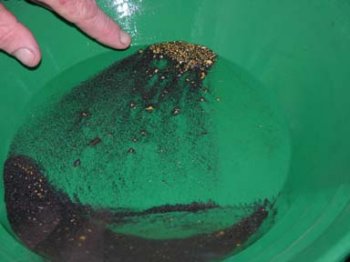
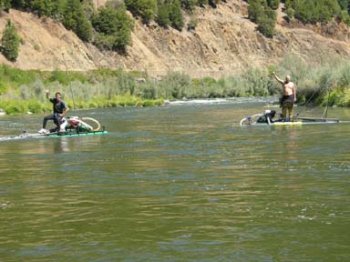
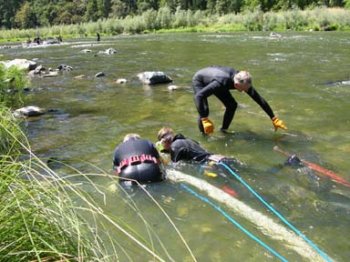
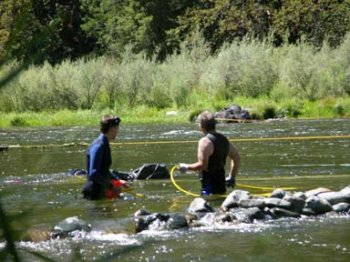
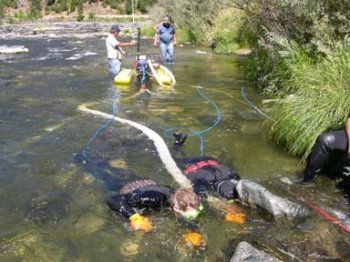 Still, as usual, most of the excitement was taking place on the beginner-dredge. There, it seemed like every few minutes, they were passing up more gold nuggets that they were digging out of the bedrock. I swear, there were times the whole bunch of them were jumping up and down, yelling. Several times, I thought the more serious dredges were going to shut down just to go over and see what all the yelling was about!
Still, as usual, most of the excitement was taking place on the beginner-dredge. There, it seemed like every few minutes, they were passing up more gold nuggets that they were digging out of the bedrock. I swear, there were times the whole bunch of them were jumping up and down, yelling. Several times, I thought the more serious dredges were going to shut down just to go over and see what all the yelling was about!